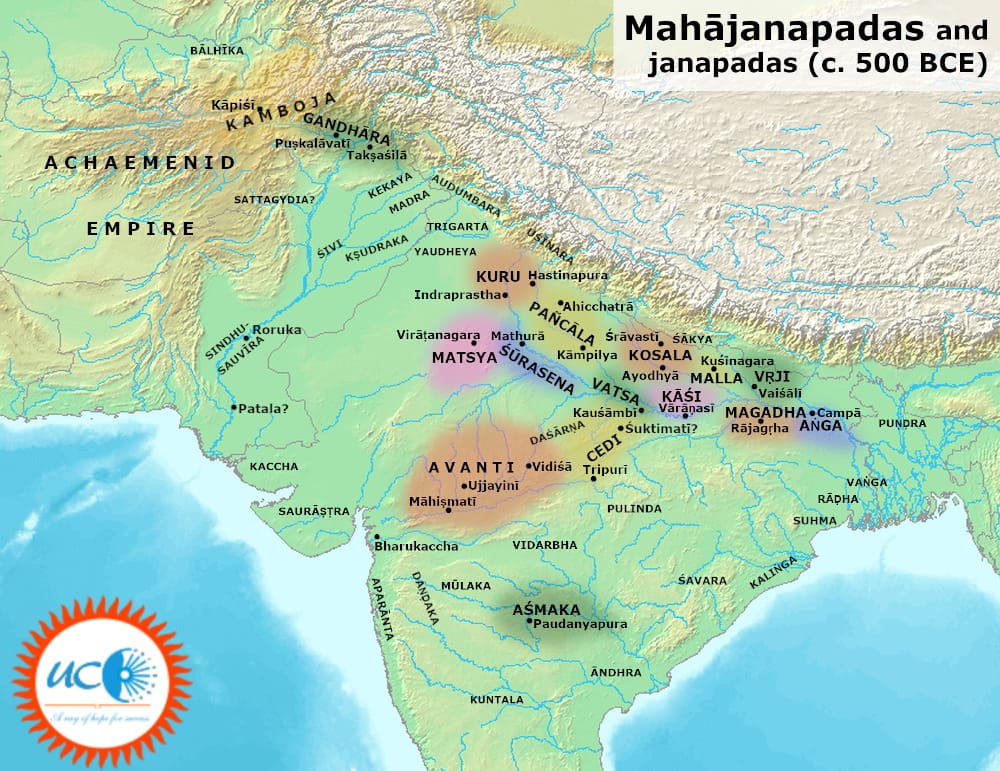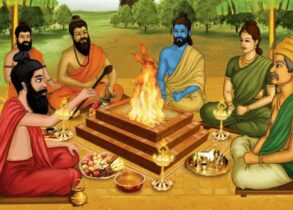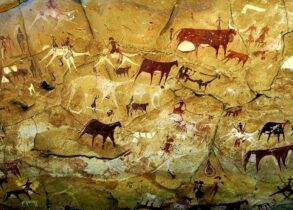Mahajanapadas
Mahajanapadas(600 BCE) is also known as the the period of 2nd urbanization. The centre of activity shifted from the upper Ganga valley or madhyadesha to middle and lower Ganga valleys known in the contemporary Buddhist texts as majjhimadesha. Agriculture flourished due to the availability of fertile lands and iron production increased due to availability of iron ore in large quantities.
Mahajanapadas from Janapadas
The vedic period witnessed the rise of Janapadas. By 6th century there were roughly 23 distinct janapadas. The janapadas fought with one another to reinforce their sovereignity. Some janapadas far exceeded their domain over other janapadas and came to be known as mahajanpadas. 16 mahajanapadas came during this time.
List of 16 Mahajanapadas name that emerged as per Buddhist texts Anguttara Nikaya :
| Name | Capital | Important facts. |
| Anga | Champa | The reference is found in Mahabharata and Atharva Veda. |
| It was taken over by Magadha ruler Bimbisara. | ||
| situated in present-day Bihar and West Bengal. | ||
| Magadha | Girivraja/ Rajagriha | Magadha finds mention in the Atharva Veda. |
| Location in present-day Bihar close to Anga. | ||
| The first buddhist council was held here. | ||
| Under Bimbisara and Ajatashatru the capital was Girivraja but Udayin shifted the capital to Pataliputra. Sisunaga further changed it to Vaishali, which remained the capital till the end of the Nandas. | ||
| Kasi/Kashi | Kasi | It was located in Varanasi. |
| Kasi was captured by Kosala. | ||
| Vatsa | Kausambi | Vatsa is also known as Vamsa. |
| Located on the banks of the Yamuna. | ||
| This was a central city for economic activities. | ||
| The ruler Udayana made Buddhism a state religion. | ||
| Kosala | Shravasti (northern), | location in modern Awadh region of Uttar Pradesh. |
| Kushavati (southern) | Kosala also included the tribal republican territory of Sakyas of Kapilavastu. Lumbini in Kapilavastu is the birthplace of Gautama Buddha. | |
| Important king – Prasenajit (Buddha’s contemporary) | ||
| Shurasena | Mathura | Important king – Awantipura (Disciple of Buddha). |
| Panchala | Ahichchatra and Kampilya | The famous city of Kannauj was situated in the Kingdom of Panchala. |
| Later the nature of governance shifted from monarchy to republic. | ||
| Kuru | Indraprastha | The area around Kurukshetra was apparently the site for Kuru Mahajanapada. |
| Mahabharata epic narrates conflict between two branches of the reigning Kuru clan. | ||
| Matsya | Viratanagara | It is situated around present-day Jaipur, Alwar and Bharatpur area of Rajasthan. |
| Founder – Virata | ||
| Chedi | Sothivati | This was cited in the Rigveda. |
Over the time weaker empires and republics got subdued by the more powerful rulers. In the 6th century, only 4 influential kingdoms stayed:
- Magadha
- Avanti
- Kosala
- Vatsa
Later, all of them became part of Magadha.
SOME COMMON FEATURES.
- Emergence of territorial states called the mahajanapadas from the smaller ones of the later Vedic period which, as we have seen, were known as the janapadas
- Painted grey ware pottery was replaced by richer and shinier northern black polished ware
- heterodox belief systems leading intellectual revolution, expansion of trade and commerce leading to the second phase of urbanization in the region of Ganga valley
- Increased surplus production resulting expansion of trading activities
- increase in the amount of taxes for the ruler due to surplus production.
- The ruling and the priestly elites control most of the agricultural surplus produced by the vaishyas and the shudras(working as labourers).
- The varna system became more consolidated.
- Jainism and Buddhism gain popularity.
- They posed serious challenge to the Brahmanical socio-religious philosophy. These belief systems had a primary aim to liberate the lower classes from the fetters of orthodox Brahmanism.
- By the middle of the sixth century BC, Magadha seems to have emerged as the most powerful state by liquidating all the other mahajanapadas.
- In due course of time, it reached the status of an Empire under the Nandas, who prepared a suitable ground before the coming of the mighty Mauryas.






